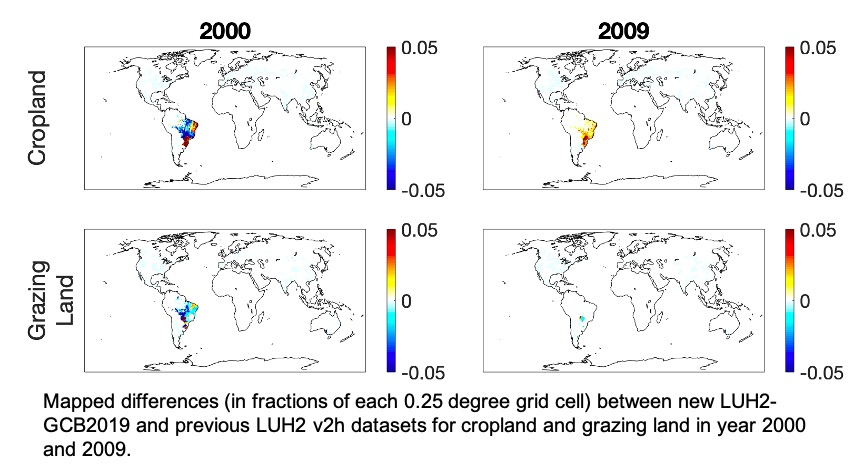Associate Research Professor Louise Chini, along with GEOG researchers George Hurtt, Ritvik Sahajpal, Lei Ma, and Benjamin Poulter, as well as an international team of collaborators, published a paper in the journal Earth System Science Data entitled "Land-use harmonization datasets for annual global carbon budgets". This paper builds upon the Land-Use Harmonization datasets used for both CMIP5 and CMIP6 synthesis studies, and describes a methodology for annually updating these datasets for use in the Global Carbon Budget (GCB) publications. This methodology involves trade-offs between incorporating the latest data updates while also maintaining consistency with climate simulations and across annual assessments, along with challenges of retrospective input-data changes. The paper also discusses the specific dataset produced for GCB 2019, which took advantage of new data inputs that corrected recent cropland and grazing land areas within the globally important region of Brazil.
The full abstract of the paper is presented below:
Land-use change has been the dominant source of anthropogenic carbon emissions for most of the historical period and is currently one of the largest and most uncertain components of the global carbon cycle. Advancing the scientific understanding on this topic requires that the best data be used as input to state-of-the-art models in well-organized scientific assessments. The Land-Use Harmonization 2 dataset (LUH2), previously developed and used as input for simulations of the 6th Coupled Model Intercomparison Project (CMIP6), has been updated annually to provide required input to land models in the annual Global Carbon Budget (GCB) assessments. Here we discuss the methodology for producing these annual LUH2-GCB updates and extensions which incorporate annual wood harvest data updates from the Food and Agriculture Organization (FAO) of the United Nations for dataset years after 2015 and the History Database of the Global Environment (HYDE) gridded cropland and grazing area data updates (based on annual FAO cropland and grazing area data updates) for dataset years after 2012, along with extrapolations to the current year due to a lag of 1 or more years in the FAO data releases. The resulting updated LUH2-GCB datasets have provided global, annual gridded land-use and land-use-change data relating to agricultural expansion, deforestation, wood harvesting, shifting cultivation, regrowth and afforestation, crop rotations, and pasture management and are used by both bookkeeping models and dynamic global vegetation models (DGVMs) for the GCB. For GCB 2019, a more significant update to LUH2 was produced, LUH2-GCB2019 (https://doi.org/10.3334/ORNLDAAC/1851, Chini et al., 2020b), to take advantage of new data inputs that corrected cropland and grazing areas in the globally important region of Brazil as far back as 1950. From 1951 to 2012 the LUH2-GCB2019 dataset begins to diverge from the version of LUH2 used for the World Climate Research Programme's CMIP6, with peak differences in Brazil in the year 2000 for grazing land (difference of 100 000 km2) and in the year 2009 for cropland (difference of 77 000 km2), along with significant sub-national reorganization of agricultural land-use patterns within Brazil. The LUH2-GCB2019 dataset provides the base for future LUH2-GCB updates, including the recent LUH2-GCB2020 dataset, and presents a starting point for operationalizing the creation of these datasets to reduce time lags due to the multiple input dataset and model latencies.
The full paper can be accessed here: https://essd.copernicus.org/articles/13/4175/2021/


